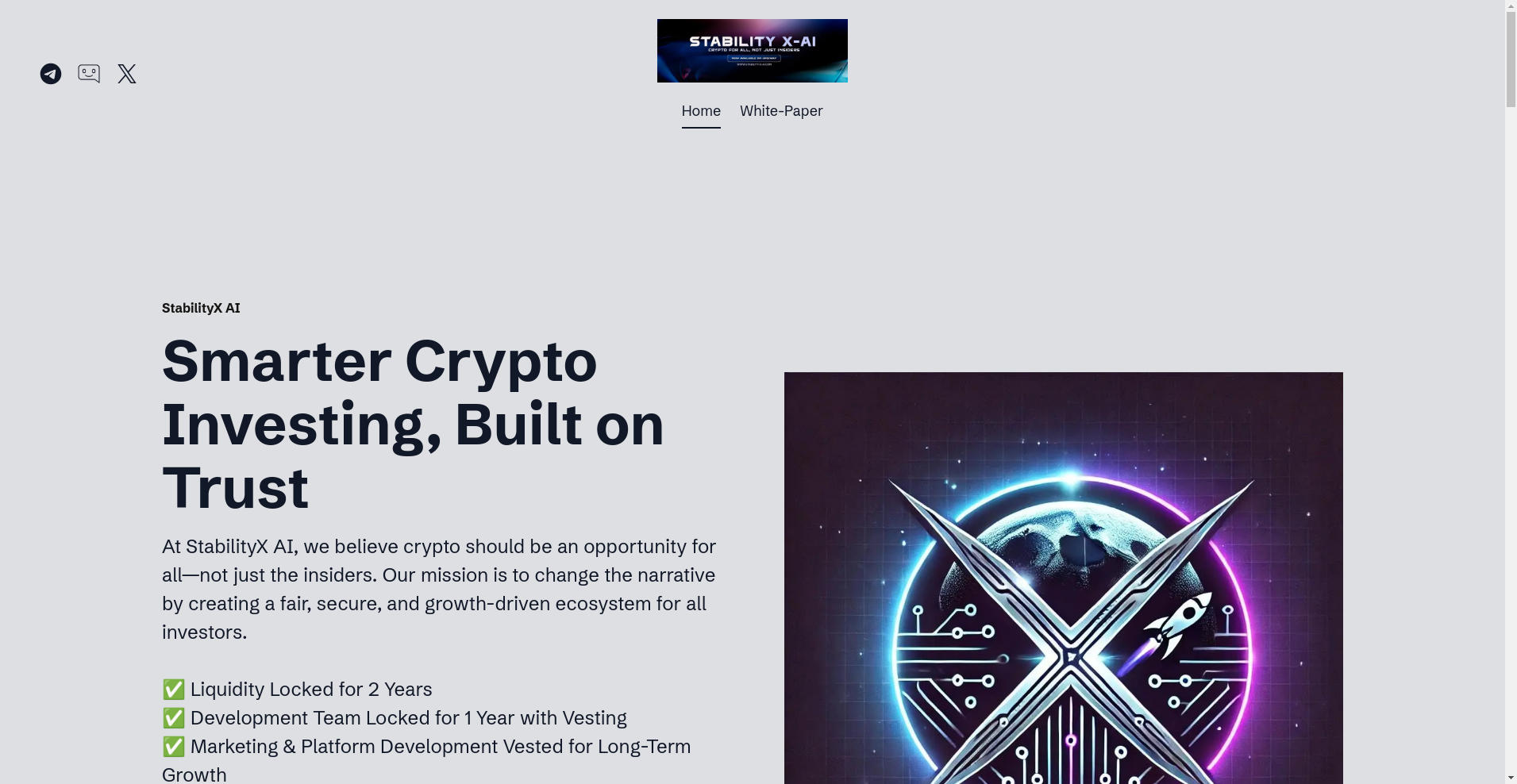stabilityX AI Review: Scam or Legit Crypto? Uncovering All The Red Flags

What Exactly Is stabilityX AI?
stabilityX AI presents itself as a forward-thinking cryptocurrency project rooted in principles of security, transparency, and community empowerment. Its creators claim to be building a long-term ecosystem aimed at democratizing crypto investing by providing AI-driven insights and promoting stability through rigorous lock-in measures.
However, as with many projects touting high security and revolutionary goals, skepticism is warranted. This article conducts a thorough investigation into the claims made by stabilityX AI, analyzing its background, security audits, tokenomics, and overall legitimacy to help investors discern fact from fiction.
Who Is The Team Behind stabilityX AI?
The credibility of any crypto project heavily depends on the transparency and background of its team. In the case of stabilityX AI, there is limited publicly available information about the founders or development team. The project emphasizes long-term locking mechanisms and comprehensive audits but does not disclose specific team members or their credentials, which raises some red flags.
Assessing the provided roadmap and promotional materials, the project's narrative revolves around strong security commitments like liquidity and developer locks, along with audit and KYC verifications, which are often used to build trust. Nonetheless, without doxxed founders or verifiable identities, questions remain about accountability and long-term transparency.
- Roadmap & Vision: The project ambitiously aims to create an inclusive, stable, and transparent ecosystem, with plans for app expansion, community tools, and educational features.
- Security pledges: Locks on liquidity and team tokens for up to a year or more, with an emphasis on anti-rug pull measures.
- Audit & Compliance: Conducted by Cyberscope, which provides some assurance, but the oversight of team credentials is lacking.
Summary: While the project's security measures and audit commitments may seem reassuring, the absence of transparent identities creates doubt about the true intentions behind stabilityX AI.
stabilityX AI Security Audit: A Deep Dive into the Code
The only formal audit available for stabilityX AI was performed by Cyberscope, a known auditing firm. The audit assessed the token's contract, primarily focusing on vulnerabilities, centralization risks, and code security. While the project boasts a high security score of approximately 95%, it's crucial to understand what this entails.
- Security Score: Approximately 95 out of 100, indicating that Cyberscope found minimal vulnerabilities in the code.
- Critical Issues: One high-criticality concern was noted during the assessment, but specifics are not detailed publicly, which is typical in limited audit summaries.
- Potential Risks: The audit covers smart contract issues, but does not necessarily address centralization risks, governance vulnerabilities, or overall project control.
- Audit Transparency: The audit appears comprehensive, but reliance solely on Cyberscope and limited public access to full report details limits the ability to independently verify security quality.
In summary, while the smart contract appears technically secure, the audit does not entirely eliminate the possibility of vulnerabilities or malicious code. Additionally, the audit’s limited scope and lack of full transparency warrant caution.
stabilityX AI Tokenomics: A Fair System or a Trap?
The tokenomics of stabilityX AI are designed with an emphasis on long-term stability and investor confidence. The project claims to have locks on liquidity and team tokens, which are positive signals, but the devil is in the details.
- Total Supply: Not explicitly detailed, but implied to be limited to prevent inflationary pressures.
- Distribution: The project mentions lock-ups for liquidity (2 years), team tokens (1 year lock with vesting), and vested funds for marketing and development, suggesting a controlled release schedule.
- Team & Developer Allocation: Locked for 1 year, aligning team success with project longevity—yet the actual amount allocated to team members is not publicly disclosed.
- Utility & Incentives: The token is promoted as a vehicle for AI-driven insights and long-term growth, but specific use cases and governance rights are unclear.
- Risks: The lack of transparency around total supply and detailed distribution makes it hard to assess potential dump risks—a common concern with early-stage projects.
Overall, while the tokenomics are presented as investor-friendly and security-conscious, the opacity surrounding key figures raises the possibility of future large dumps or inflation, especially if undisclosed allocations exist.
Beyond the Hype: Is stabilityX AI Actually Being Built?
The project claims to have made tangible progress, including a live deployment on Uniswap, with a functional token and a roadmap promising advanced features. The official website and whitepaper highlight development milestones, audit verification, and community engagement initiatives.
However, a deeper look reveals that the project’s activity appears somewhat limited. The Discord server has no active members (roughly zero engagement), and Twitter followers are minimal, which is unusual for a project with such ambitious claims. The provided summaries suggest ongoing development, but no major updates or feature rollouts are evident beyond initial launch preparations.
Thus, the legitimacy of their progress remains questionable—are they genuinely building, or is the narrative just marketing fluff designed to attract early investors? The absence of clear, quantifiable progress updates and real-time activity suggests caution, as many scam projects launch a minimal product to create inflated perceived value.
What stabilityX AI's Legal Documents Are Hiding
Aside from promotional statements and audited smart contracts, there is little publicly available legal information. The project does not publish detailed terms of service, privacy policies, or user agreements, which could be concerning for investors. A notable issue is the lack of clear disclaimers regarding project liabilities or recourse if issues arise post-investment.
- No Legal Transparency: Absence of comprehensive legal documentation increases risks of misrepresentation or legal vulnerabilities.
- Potential Red Flags: Vague terms and the undisclosed identity of team members may be exploited to evade accountability or legal obligations.
- Impact on Investors: Limited legal protections could mean difficulties in pursuing claims if scams or disputes occur later.
In essence, the legal framework supporting stabilityX AI seems underdeveloped, a common trait among dubious projects seeking to evade scrutiny or accountability.
Final Verdict: Should You Risk Investing in stabilityX AI?
This investigation reveals a mixed picture of stabilityX AI. On the surface, it promotes the ideals of security, transparency, and community-driven growth, backed by an audit and lock-in measures that seem promising. Nonetheless, several red flags undermine confidence: the lack of doxxed team members, limited transparency on tokenomics details, questionable real-world activity, and minimal legal documentation.
While the project’s security audit by Cyberscope is a positive sign, it's not enough to dismiss the inherent risks associated with projects that lack clear leadership and transparent operations.
- Positive Points:
- Security score suggests smart contract safety
- Liquidity and developer locks indicate anti-rug pull measures
- Audit and KYC verified
- Claims of long-term commitment and transparency efforts
- Major Red Flags:
- Absence of transparent, publicly verified team members
- Limited activity and engagement signals actual implementation doubts
- Opaque tokenomics and undisclosed allocation details
- Poor legal transparency and accountability
- Reliance on a single audit with a limited scope
Given these findings, investors should approach stabilityX AI with caution. It’s imperative to perform thorough due diligence and avoid investing funds you cannot afford to lose. As always, ensure your investment decisions are based on comprehensive research and risk awareness—especially in the unpredictable world of cryptocurrency.

James Carter
Chief On-Chain Analyst
On-chain analyst with a background in financial fraud detection. I use data science to dissect blockchains, find the truth, and expose scams. My motto: code doesn't lie.
Similar Projects
-
Starlay Finance
Starlay Finance ($LAY) Review: Risks & Opportunities in DeFi
-
Cyberware
Cyberware Review: Assessing Its Security, Transparency & Risks
-
Angry Bird INU
Crypto Project Review: Is Angry Bird INU a Scam or Legit? Scam Checker & Analysis
-
AI Dragon
AI Dragon Review: Is This Crypto Project a Scam? Crypto Scam Checker & Project Review
-
Shelter of Exiles
Comprehensive Review of Shelter of Exiles: Is This Crypto Project a Scam or Legit?